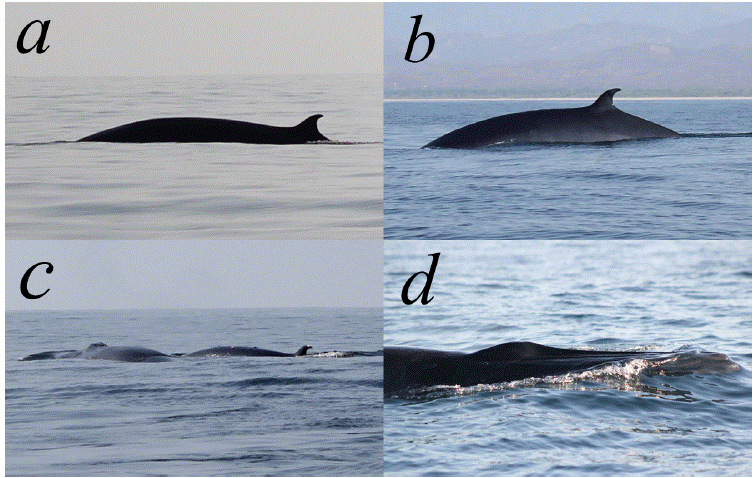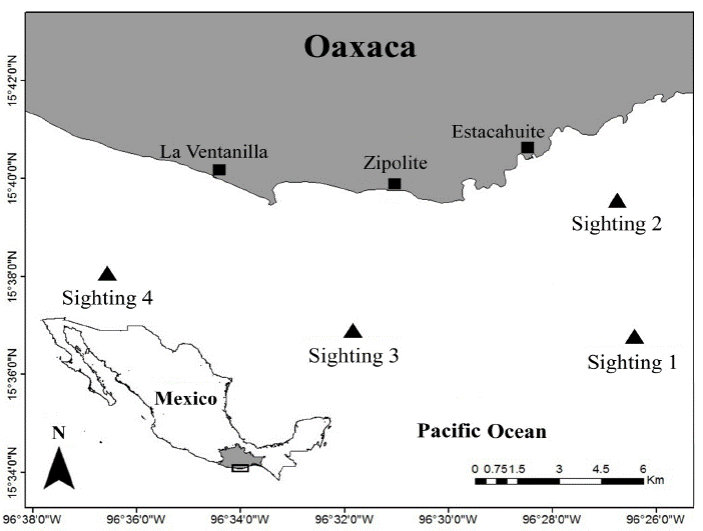Introduction
The Bryde's whale, Balaenoptera edeni (Anderson, 1879), is probably the least studied baleen whale; it is listed in the Data Deficient (DD) risk category of the International Union for the Conservation of Nature's Red List (IUCN 2016), and is classified as a species subject to special protection (Pr) in the Mexican Official Standard NOM-059-SEMARNAT-2010 (DOF 2010). It can be identified by the presence of three parallel longitudinal ridges on top of the rostrum, unlike other rorquals, which possess a single ridge (Jefferson et al. 1993; Carwardine 2002). The prominence of these ridges is variable and difficult to observe from a research boat at sea; for this reason, this species was misidentified as either the sei whale (B. borealis; Jefferson et al. 1993) or other species such as the fin whale (B. physalus) and the antarctic minke whale or southern minke whale (B. bonaerensis; Niño-Torres et al. 2011). It has a relatively small, elongated and slim body that measures up to 14.6 m (Reeves et al. 2002). The pectoral fins are relatively short and with a pointed tip, and the dorsal fin is prominent and falcate, located at about two thirds of the total body length (Carwardine 2002; Reeves et al. 2002). The body coloration pattern is variable, being black-bluish dorsally and white or yellowish ventrally (Guerrero-Ruíz et al. 2006; Niño-Torres et al. 2011).
The Bryde's whale has a pan-tropical distribution between 40° N and 40° S, or delimited by the 20 °C isotherm, and can be seen near the coast and in areas of high productivity (Carwardine 2002; Guerrero-Ruíz et al. 2006). In the North Pacific, it is found from California to Central America, and in the Mexican Pacific its potential distribution may extend south to 26°N, from Baja California along the continental coast of Mexico to the border with Guatemala (Urbán and Flores 1996; Urbán and Guerrero-Ruíz 2008). Some authors have suggested the existence of two populations in the Gulf of California: a resident one, of which calves have been observed throughout the year, and another one associated with the Eastern Tropical Pacific population (Tershy et al. 1990; Niño-Torres et al. 2011). In the Mexican South Pacific, the knowledge about the species is scarce, particularly for the coast of Oaxaca, where the presence of this species has not been previously recorded.
During oceanic trips for monitoring the migration of the humpback whale (Megaptera novaeangliae) in the Central Coast of Oaxaca, conducted by Mamíferos Marinos de Oaxaca Biodiversidad y Conservación Asociación Civil (MMOBiDiC AC) and Universidad del Mar, four sightings of B. edeni were recorded between December 2011 and January 2012. The observation platforms used were 6 m fiberglass boats with a 60 hp outboard engine. B. edeni was first identified based on the presence of the three ridges on top of the rostrum using the photographs and videos taken during the sightings, and comparing the morphological characteristics with the descriptions by Reeves et al. (2002).
The first two sightings occurred on 10 December 2011 (Figure 1), the first record being at 12:01 hours, 7.1 km off Estacahuite bay (15° 36' 43.4" N, -96° 26' 28.8" W), where a single specimen was observed moving slowly to the southeast and breaching on two occasions. Later, a mother and a calf were sighted at 13:07 h, 1.3 km off Estacahuite (15° 39'27.06"N, -96° 26'47.7"W), also moving slowly to the southeast. In both sightings, the local sea surface temperature was 26 °C.

Figure 1 Balaenoptera edeni individuals recorded between December 2011 and January 2012 in the central coast of Oaxaca. a and b show adult specimens; c, a mother and a calf, and d, the parallel lateral ridges on top of the rostrum that is characteristic of the species.
On 27 January 2012, two additional sightings were recorded. The first occurred at 8:21, 4.4 km from Roca Blanca island, in front of Zipolite beach (Figure 1). Five individuals were observed, including a calf (15° 36'54.1"N, -96° 31'52.0"W); sea surface temperature was 26 °C. The individuals displayed an active surface behavior along with erratic movements to the northwest, evading the observation platform with sudden changes of direction. In this occasion, three individuals of Orcinus orca (a calf and two females: an adult and a juvenile) were observed moving in the opposite direction to the group of Bryde's whales and five meters apart from them. Although there are reports of killer whales (Orcinus orca) hunting Bryde's whales in the Gulf of California (Silber et al. 1990), neither interactions nor predatory behaviors were noticed during the sighting reported here, as both groups moved away from one another in their respective directions. The second sighting was of a mother with a calf, at 9:56, 4.7 km off Ventanilla beach (15° 37' 57.4" N, -96° 36' 35.6"W), moving slowly with erratic movements to the southeast. Both individuals displayed an active surface behavior and evaded the boat; the calf performed two full-body breaches belly up (one of which was partially recorded on video). During the sighting, the emission of vocalizations or sounds by the mother were recorded on video on three occasions, after surface breathing, which were clearly audible from the boat and lasted approximately one second.
It has been suggested that the occurrence and displacement of this rorqual are influenced by prey availability, which in turn is affected by environmental variability; in the Gulf of California, a larger number of rorquals have been observed in La Niña cold conditions that facilitate the migration of sardines into the Gulf (Salvadeo et al. 2011). Its presence in the coastal area of Oaxaca may be associated with the oceanographic characteristics and high productivity that prevail in the Gulf of Tehuantepec, which define this region as a center of high biological activity (Ortega-García et al. 2000). In addition, the anchovy, a prey consumed by the Bryde's whale, (Guerrero-Ruíz et al. 2006), has been reported as one of the most abundant species, both in number and in weight, in the Gulf of Tehuantepec at the beginning of the dry season (winter-spring), when Tehuano winds give rise to upwelling events and a significant drop of sea surface temperature (Ayala-Duval et al. 1988).
On the other hand, the behaviors recorded were typical of the species, since in all sightings rorquals evaded the boat with sudden changes of direction. A remarkable fact was the fortuitous record of audible vocalizations during surface breaths, which were clearly heard from the boat.

Figure 2 Distribution of the sightings of Balaenoptera edeni in the central coast of Oaxaca between December 2011 and January 2012.
These records are relevant for being the first reports of B. edeni for the state of Oaxaca, particularly since studies on the Bryde's whale in the Mexican Pacific are scarce and the effort has focused on very specific areas of the north and west zones. These findings point to the need to conduct intensive long-term monitoring in the Mexican South Pacific, aimed at investigating ecological aspects of marine mammals, in particular focusing on the Bryde's whale, its presence throughout the year in the Pacific coast of Oaxaca, and the factors that determine its spatial and temporal occurrence in this region.
The authors would like to thank UMAR for financing the project 2IE1207, to MMOBiDiC A. C., and ALIAM S. A. de C. V. for their contribution to financing the ocean trips of the Programa Permanente de Monitoreo de Mamíferos Marinos de la Costa Central de Oaxaca. Thanks also to the volunteers who participated during the ocean trips of the program. Finally, to the anonymous reviewers who provided valuable comments to improve the manuscript. This manuscript was translated by Maria Elena Sánchez Salazar with support of THERYA through a CONACYT grant.











 nova página do texto(beta)
nova página do texto(beta)


